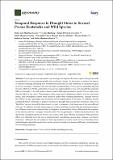Por favor, use este identificador para citar o enlazar a este item:
http://hdl.handle.net/10261/220278COMPARTIR / EXPORTAR:
 SHARE SHARE
 CORE
BASE CORE
BASE
|
|
| Visualizar otros formatos: MARC | Dublin Core | RDF | ORE | MODS | METS | DIDL | DATACITE | |

| Título: | Temporal response to drought stress in several prunus rootstocks and wild species |
Autor: | Martínez-García, Pedro J. CSIC ORCID ; Hartung, Jens; Pérez de los Cobos, Felipe CSIC ORCID; Martínez-García, Pablo; Jalili, Sara; Sánchez-Roldán, Juan Manuel; Rubio, Manuel CSIC ORCID; Dicenta, Federico CSIC ORCID; Martínez-Gómez, Pedro CSIC ORCID | Fecha de publicación: | 14-sep-2020 | Editor: | Multidisciplinary Digital Publishing Institute | Citación: | Agronomy 10(9): 1383 (2020) | Resumen: | Prunus species are important crops in temperate regions. In these regions, drought periods are predicted to occur more frequently due to climate change. In this sense, to reduce the impact of climate warming, obtaining new tolerant/resistant cultivars and rootstocks is a mandatory goal in Prunus breeding. Therefore, the current study assembled three Prunus species including almond, (P. dulcis Mill D.A. Webb), apricot (P. armeniaca L.) and peach (P. persica L.) to model the temporal effects of drought. A hybrid peach × almond and a wild almond-relative species Prunus webbii were also included in the study. Physiological traits associated with photosynthetic activity, leaf water status, and chlorophyll content were assessed under three watering treatments. Results showed that effects of time, genotype, and treatment interact significantly in all traits. In addition, results confirmed that P. webbii have a greater tolerance to drought than commercial rootstocks. However, “Real Fino” apricot showed the fastest recovery after re-irrigation while being one of the most affected cultivars. In addition, from the better response to these watering treatments by the almond genotypes, two different trends were observed after re-irrigation treatment that clearly differentiate the response of the almond cultivar “Garrigue” from the rest of Prunus genotypes. A better characterization of the short-term drought response in Prunus, an accurate and more efficient evaluation of the genotype effect was obtained from the use of mixed models considering appropriate variance–covariance structures. Although the advantages of these approaches are rarely used in Prunus breeding, these methodologies should be undertaken in the future by breeders to increase efficiency in developing new breeding materials. | Descripción: | This article belongs to the Special Issue Recent Advances in Genomics and Genetics of Fruit Trees. | Versión del editor: | https://doi.org/10.3390/agronomy10091383 | URI: | http://hdl.handle.net/10261/220278 | DOI: | 10.3390/agronomy10091383 | E-ISSN: | 2073-4395 |
| Aparece en las colecciones: | (CRAG) Artículos (CEBAS) Artículos |
Ficheros en este ítem:
| Fichero | Descripción | Tamaño | Formato | |
|---|---|---|---|---|
| drought_prunus_rootstocks_wild_species.pdf | 361,91 kB | Adobe PDF |  Visualizar/Abrir |
CORE Recommender
SCOPUSTM
Citations
9
checked on 10-abr-2024
WEB OF SCIENCETM
Citations
8
checked on 22-feb-2024
Page view(s)
125
checked on 22-abr-2024
Download(s)
233
checked on 22-abr-2024
Google ScholarTM
Check
Altmetric
Altmetric
Este item está licenciado bajo una Licencia Creative Commons

